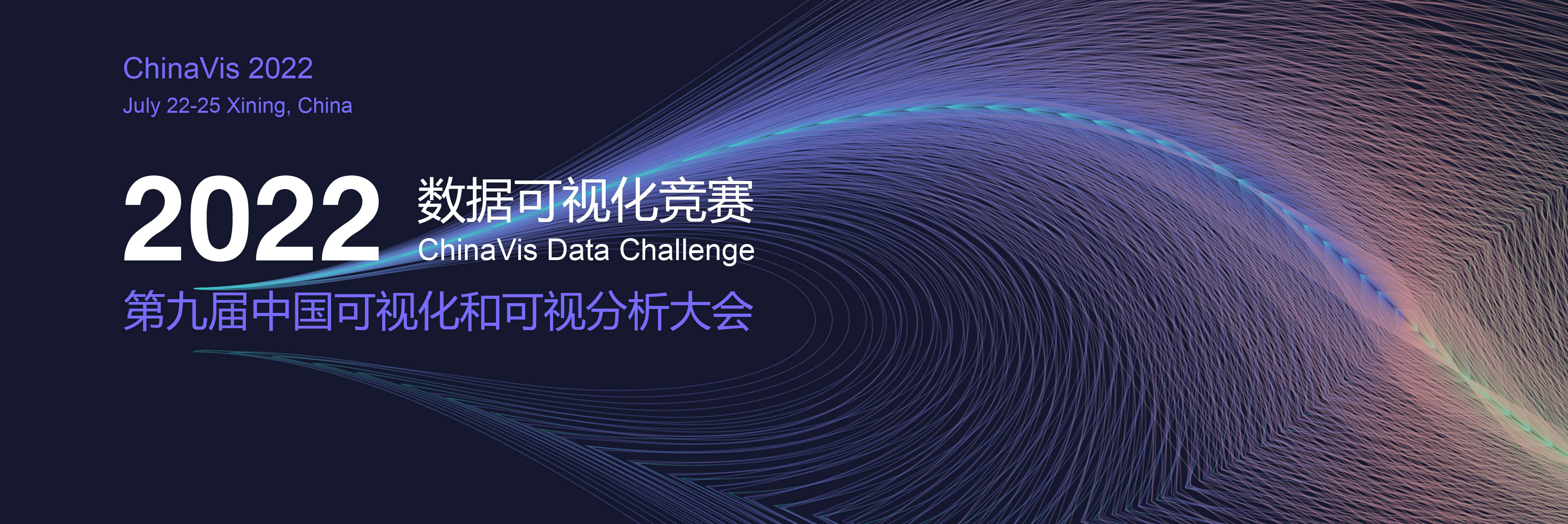The 9th China Visualization and Visual Analytics Conference (ChinaVis 2022) will be held in Xining, China, from July 22 to 25, 2022, hosted by China Society of Image and Graphics, Technical Committee on Visualization and Visual Analysis with multiple sponsorships. ChinaVis 2022 solicits two types of papers: regular papers and survey papers, both written in either Chinese or English.
Regular Papers
Accepted regular papers will be published in the Journal of Visualization for English manuscripts and Journal of Computer-Aided Design & Computer Graphics for Chinese manuscripts.
Regular papers will be reviewed in two rounds. In the first-round review, a paper is conditionally accepted if it is recommended by the reviewers. Authors need to address the issues raised by the reviewers and submit the revised manuscript to the journal submission systems for the second-round review. Papers that meet the revision requirements will be formally accepted. In the past years, the acceptance rate of regular papers was approximately 30%.
For papers with system or technique contributions, authors are recommended to submit additional materials such as a screen-captured video of their system. All submissions must be unpublished original work. If the paper has been reviewed and rejected by other international visualization conferences or journals, the authors can attach past reviews and provide a "Cover Letter" to clarify the improvement of the paper. Each submission will be reviewed anonymously by experts from multiple domains.
The conference uses the Precision Conference System (PCS) system (https://new.precisionconference.com/chinavis) for the first-round review of regular papers. Choose "Regular" paper type in the submission form. Authors are invited to submit the second-round submissions to the Journal of Visualization if the paper is conditionally accepted. Separate submission and formatting guidelines will be sent to authors for the second-round submission.
Manuscripts should be submitted in PDF format. Regular papers in English are required to use the IEEE VGTC conference template (http://www.cs.sfu.ca/~vis/Tasks/camera_tvcg.html) in the first-round review. A regular paper should be no more than 8 pages (not including references). For Chinese papers, refer to the formatting guidelines of Journal of Computer-Aided Design & Computer Graphics requirements (http://www.jcad.cn/).
- Scientific visualization
- Information visualization
- Visual analytics
- Data processing for visualization
- Interactive design and display technology in visualization
- Visualization evaluation and visual cognition
- Visualization design and systems
- Visualization and visual analytics theory
- Big data visual analytics
- Visualization and visual analytics applications (including but not limited to natural sciences, engineering, and social sciences)
- Abstract submission deadline (PCS system): May 10, 2022, Beijing time 23:59
- Full paper submission deadline (PCS system): May 15, 2022, Beijing time 23:59
- First-round acceptance notice for both survey and regular papers: June 20, 2022
- Paper revision submission deadline (journal systems): July 10, 2022, Beijing time 23:59
Survey
Accepted survey papers will be published in the Journal of Visual Informatics for English manuscripts and Journal of Computer-Aided Design & Computer Graphics for Chinese manuscripts.
Survey papers will be reviewed in a three-stage process: initial two-page sketch, first-round, and second-round reviews. First, authors are required to submit an initial sketch, which briefly describes the planned survey by outlining the topic, provides the planned structure and outline of the survey, and lists all key references. The length of a sketch is limited to two pages. Second, selected sketch authors are invited to submit a full survey paper for the first-round review. A survey paper is conditionally accepted if it is recommended by reviewers, and the authors need to revise the manuscript to address the issues raised by the reviewers and resubmit to journal submission systems. The papers that meet the revision requirements will be formally accepted.
All submissions must be unpublished original work. If the paper has been reviewed and rejected by other international visualization conferences or journals, the authors can attach the past reviews and provide a "Cover Letter" to clarify the improvement of the paper. Each submission will be reviewed anonymously by experts from multiple domains.
The conference uses the Precision Conference System (PCS) system (https://new.precisionconference.com/chinavis) for the review of initial sketches and first-round submissions. Choose "Survey" paper type in the submission form. Authors are required to submit the second-round submissions to Visual Informatics or Journal of Computer-Aided Design and Computer Graphics. Separate instructions will be sent to authors if the paper is conditionally accepted by the first-round review.
Survey papers in English are required to use the Visual Informatics template requirements (https://www.elsevier.com/authors/author-schemas/latex-instructions). For Chinese survey papers, refer to the Journal of Computer-Aided Design & Computer Graphics requirements (http://www.jcad.cn/)
Examples for past survey papers in English:
- https://www.sciencedirect.com/science/article/pii/S2468502X19300440
- https://www.sciencedirect.com/science/article/pii/S2468502X20300292
- https://www.sciencedirect.com/science/article/pii/S2468502X19300452
- http://shixialiu.com/publications/survey-cvm/paper.pdf
- https://wwxkxmm.github.io/pdf/Intelligent_Vehicle.pdf
- Two-page sketch submission deadline (PCS system): April 15, 2022, Beijing time 23:59
- Notifications to invite full paper submission: April 18, 2022
- Full paper submission deadline (PCS system): May 15, 2022, Beijing time 23:59
- First-round acceptance notification: June 20, 2022
- Paper revision submission deadline (journal systems): July 10, 2022, Beijing time 23:59
For any questions, please contact: paper.chinavis@gmail.com.
General Chairs:
- Shengling Geng, Qinghai Normal University
- Gang Liu, China University of Geosciences (Wuhan)
Paper Chairs
- Jian Zhao, University of Waterloo
- Yunhai Wang, Shandong University
- Ying Zhao, Central South University
International Program Committee
- Chongke Bi, Tianjin University
- Yi Cao, Institute of Applied Physics and Computational Mathematics
- Qing Chen, Tongji University
- Siming Chen, Fudan University
- Xiaohui Chen, Information Engineering University
- Yi Chen, Beijing Technology and Business University
- Yingjie Chen, Purdue University
- Changjian Chen, Kuaishou Technology Co., Ltd.
- Zhutian Chen, Harvard University
- Shenghui Cheng, Westlake University
- Guihua Shan, Computer Network Information Center, Chinese Academy of Sciences
- Xiaoju Dong, Shanghai Jiao Tong University
- Yi Du, Computer Network Information Center, Chinese Academy of Sciences
- Siwei Fu, Zhejiang Lab
- Liang Gou, Bosch Research
- Dongliang Guo, Yanshan University
- Haibo Hu, Chongqing University
- Cui Xie, Ocean University of China
- Chenhui Li, East China Normal University
- Guozheng Li, Beijing Institute of Technology
- Jie Li, Tianjin University
- Quan Li, ShanghaiTech University
- Tiemeng Li, Beijing University of Posts and Telecommunications
- Christy Jie Liang, University of Technology Sydney
- Juncong Lin, Xiamen University
- Dongyu Liu, Massachusetts Institute of Technology
- Le Liu, Northwestern Polytechnical University
- Richen Liu, Nanjing Normal University
- Aidong Lu, University of North Carolina at Charlotte
- Min Lu, Shenzhen University
- Yuetong Luo, Hefei University of Technology
- Yuxin Ma, Southern University of Science and Technology
- Zhibin Niu, Tianjin University
- Jiansu Pu, University of Electronic Science and Technology of China
- Hongxing Qin, Chongqing University
- Yang Shi, Tongji University
- Lei Shi, Beihang University
- Xinhuan Shu, The Hong Kong University of Science and Technology
- Guodao Sun, Zhejiang University of Technology
- Maoyuan Sun, Northern Illinois University
- Ying Tang, Zhejiang University of Technology
- Tan Tang, JD Intelligent Cities Research
- Jun Tao, Sun Yat-sen University
- Yubo Tao, Zhejiang University
- Qianwen Wang, Harvard University
- Junpeng Wang, Visa Research
- Wenke Wang, National University of Defense Technology
- Xiaohui Wang, University of Science and Technology Beijing
- Xumeng Wang, Nankai University
- Yong Wang, Singapore Management University
- Yun Wang, Microsoft Research Asia
- Changbo Wang, East China Normal University
- Zuchao Wang, Qihoo 360
- Di Weng, Microsoft Research Asia
- Xiangyang Wu, Hangzhou Dianzi University
- Yadong Wu, Sichuan University of Science and Engineering
- Jiazhi Xia, Central South University
- Meng Xia, Carnegie Mellon University
- Xiao Xie, Zhejiang University
- Yalong Yang, Virginia Tech
- Hongfeng Yu, University of Nebraska-Lincoln
- Lingyun Yu, Xi'an Jiaotong-Liverpool University
- Haipeng Zeng, Sun Yat-Sen University
- Qiong Zeng, Shandong University
- Wei Zeng, The Hong Kong University of Science and Technology (Guangzhou)
- Huijie Zhang, Northeast Normal University
- Jiang Zhang, Huawei Technologies Co., Ltd.
- Xiaolong Zhang, Pennsylvania State University
- Fan Zhao, The Xinjiang Technical Institute of Physics & Chemistry, Chinese Academy of Sciences
- Fangfang Zhou, Central South University
- Liang Zhou, Peking University
- Zhiguang Zhou, Hangzhou Dianzi University
- Min Zhu, Sichuan University




